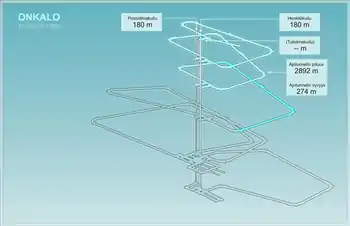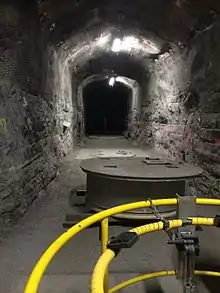Onkalo spent nuclear fuel repository
The Onkalo spent nuclear fuel repository is a planned deep geological repository for the final disposal of spent nuclear fuel.[1][2] It is near the Olkiluoto Nuclear Power Plant in the municipality of Eurajoki, on the west coast of Finland. It is being constructed by Posiva, and is based on the KBS-3 method of nuclear waste burial developed in Sweden by Svensk Kärnbränslehantering AB (SKB). The facility is expected to be operational in 2023.[3]


History
After the Finnish Nuclear Energy Act[4] was amended in 1994 to specify that all nuclear waste produced in Finland must be disposed of in Finland, Olkiluoto was selected in 2000 as the site for a (very) long-term underground storage facility for Finland's spent nuclear fuel. The facility, named "Onkalo" (meaning "small cave" or "cavity")[5] is being built in the granite bedrock at the Olkiluoto site, about five kilometers from the power plants. The municipality of Eurajoki issued a building permit for the facility in August 2003 and excavation began in 2004.[6]
The site was selected after a long process, which started in 1983 with a screening of the whole Finnish territory. From 1993 until 2000, four prospective sites were examined: Romuvaara in Kuhmo, Kivetty in Äänekoski, Olkiluoto in Eurajoki and Hästholmen in Loviisa. Besides geological and environmental considerations, the opinions of local residents were also taken into account. Eurajoki and Loviisa were singled out for being the locations with the highest local support. The former also had more favorable geographic conditions, thus in 1999 Posiva proposed it to the Finnish government as the selected location. The municipality of Eurajoki confirmed its approval of the site, and the national government ratified the decision in May 2001.[7]
Posiva started construction of the site in 2004.[8] The Finnish government issued the company a licence for constructing the final disposal facility on 12 November 2015.[9] As of June 2019 Posiva expects operations to begin in 2023.[10]
Construction

The facility was constructed by and will be operated by Posiva, a company owned by the two existing producers of nuclear power in Finland, Fortum and TVO. (Fennovoima, a company which is currently planning its first nuclear reactor, is not a stockholder of Posiva.)
The facility's constructions plans are divided into four phases:
- Phase 1 (2004–09) focused on excavation of the large access tunnel to the facility, spiraling downward to a depth of 420 metres (1,380 ft).[11]
- Phase 2 (2009–11) continued the excavation to a final depth of 520 metres (1,710 ft). The characteristics of the bedrock were studied in order to adapt the layout of the repository.
- In 2012, Posiva submitted an application for a license to construct the repository. The license was granted in November 2015.[12]
- Phase 3 (2015–17) construction of the repository
- Phase 4, the encapsulation and burial of areas filled with spent fuel, is projected to begin around 2020.
Once in operation, the disposal process will involve placing twelve fuel assemblies into a boron steel canister and enclosing it in a copper capsule. Each capsule will then be placed in its own hole in the repository and overpacked with bentonite clay. The estimated cost of this project is about €818 million, which includes construction, encapsulation, and operating costs. The State Nuclear Waste Management Fund has approximately €1.4 billion from charges for generated electricity.[13]
The Onkalo repository is expected to be large enough to accept canisters of spent fuel for around one hundred years, i.e. until around 2120.[14] At this point, the final encapsulation and burial will take place, and the access tunnel will be backfilled and sealed.
Criticism
In 2012, a research group at the Royal Institute of Technology in Stockholm, Sweden, published research that suggests that the copper capsules are not as corrosion-proof as the companies planning the repositories claim (see KBS-3).[15] In 2019, another study concluded that radiation effects should not significantly damage the canisters after 100,000 years.[16]
Treatment in media
Danish director Michael Madsen has co-written and directed a feature-length documentary Into Eternity where the initial phase of the excavation is featured and experts interviewed. The director's special emphasis is on the semantic difficulties in meaningfully marking the depository as dangerous for people in the distant future.[17][14]
References and notes
- Black, Richard (2006-04-27). "Finland buries its nuclear past". BBC. Retrieved 2020-03-03.
- Gopalkrishnan, Asha (2017-10-01). "The ominous underbelly of Finland's pioneering nuclear-waste repository". The Caravan. Retrieved 2020-03-03.
- "Nuclear Energy in Finland | Finnish Nuclear Power - World Nuclear Association". www.world-nuclear.org.
- "Nuclear Energy Act (990/1987) (in English)" (PDF). Finlex. Retrieved 2020-03-03.
- Räisänen, Alpo (2010). "Onkamo and other place names". Virittäjä. 4/2010 (114). Archived from the original on 2011-07-24. Retrieved 2020-03-03.
- "Nuclear Waste Management in Finland" (PDF). Energiateollisuus. Archived from the original (PDF) on 2011-02-23. Retrieved 2020-03-03.
- "Selecting the Site: the final disposal at Olkiluoto". Posiva. Retrieved 2020-03-03.
- "The Construction of ONKALO". Posiva. Retrieved 2020-03-03.
-
"Licence granted for Finnish used fuel repository". World Nuclear News. 2015-11-22. Retrieved 2020-03-03.
Posiva expected construction work on the repository to start in late 2016 and operations to begin in 2023
- "Work starts on Finnish fuel encapsulation plant". World Nuclear News. 2019-06-25. Retrieved 2020-03-03.
- "Finland's nuclear waste bunker built to last 100,000 years". CNN. 2010-12-09. Retrieved 2020-03-03.
- "ONKALO". Posiva. Retrieved 2020-03-03.
- "Nuclear Power in Finland". World Nuclear Association. February 2008. Retrieved 2020-03-03.
- "Into Eternity". Intoeternitymovie.com. Archived from the original on 2015-02-04. Retrieved 2020-03-03.
- Peter Szakálos and Seshadri Seetharaman (2012). "Technical Note 2012:17: Corrosion of copper canister" (PDF). Strålsäkerhetsmyndigheten. ISSN 2000-0456. Retrieved 2020-03-03.
- Yang, Qigui; Toijer, Elin; Olsson, Pär (February 2019). "Technical Report TR-19-14: Analysis of radiation damage in the KBS-3 canister materials" (PDF). Swedish Nuclear Fuel and Waste Management Co. Retrieved 2020-03-03.
- Edan Corkill (2012-01-15). "Danger! Nuclear waste! Keep out — forever!". Japan Times. Retrieved 2020-03-03.
External links
- "Envisioning Landscapes Of Our Very Distant Future" (Vincent Ialenti) NPR Cosmos & Culture (2014).
- "Pondering 'Deep Time' Could Inspire New Ways To View Climate Change" (Vincent Ialenti) NPR Cosmos & Culture (2014).
- "Deep Time Reckoning" (Vincent Ialenti) The MIT Press (2020).
- "Death & Succession Among Finland's Nuclear Waste Experts" (Vincent Ialenti) Physics Today, 70, 10, 48 (2017).
- "Sebastian Musch: The Atomic Priesthood and Nuclear Waste Management - Religion, Sci-fi Literature and the End of our Civilization